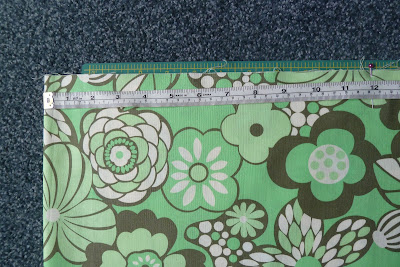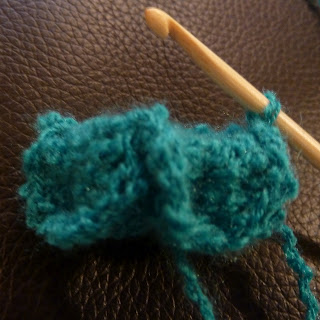I taught myself to knit as a teenager (I used to sneak off and max
out my library card with crafting books!) and almost anyone who knits
would agree that knitting flat on two straight needles is so much easier
than knitting in-the-round, either using DPNs or the magic loop
method. When I first tried to crochet almost ten years ago, it was a
rather brief affair because I mistakenly assumed that working in rows
would be easier than in continuous rounds. Boy was I wrong - I lost
count of my stitches, got all confused trying to remember how to work a
double, half-treble, treble, long treble (because the books teach you
stitch after stitch after stitch, of course I assumed I'd have to master
them all before I could make anything), and I did not respect or even
understand the turning chain.
The Japanese art of
amigurumi has become very popular recently and largely relies on working
double crochet in continuous rounds.... You do not need to be a
crochet master in order to make beautiful toys - all you need to know is
how to make a chain, double crochet, increase and decrease.
This 'tutorial' works through starting, increasing 6 stitches evenly on each round, working straight without shaping and decreasing 6 stitches evenly on each round. Tips are given on using stitch markers and also for shaping and round counting 'by eye'.
Keeping track of your stitches
When
you first start out, you will definitely need to use stitch markers.
You can buy split ring markers or use small safety pins. I prefer to
use a small length of contrast yarn because I find split ring markers
often fall out making you lose your place. The nice thing about
contrast yarn is that you can continue working without moving it every
round and you can keep trailing it through your work and pull it out when
you're done with it. One of the most useful tools is to simply count -
most decent patterns will state the number of stitches you should have
at then end of each round. Many people obsess over moving their stitch markers at the end of every round, but it is so much easier to learn how to work without them (my stitch markers constantly fell out when I first started out in crochet and I just ended up unravelling my work because I'd lost track of where I'd got to!!!) because if you understand your work, it's so much easier to figure out which point you've reached in your pattern.
Starting
During my time doing crochet, I have come across a two methods of starting working crochet in-the-round. The first is simply to work two chain and then work the required number of stitches into the 2nd chain from the hook. I prefer the magic circle method. Is is not appropriate for all types of yarn, in particular bumpy or lumpy yarns, for which it is best to use the 2-chain method.
The Magic Circle
The magic circle takes a little bit of practise, but once you've got it cracked, it s quite simple. The right-handed instructions for working double crochets into a magic circle assume prior knowledge of how to hold the hook and the working yarn, working chains, and working double crochets (US singles)
Make a loop around the index and middle fingers of your
left hand such that the working yarn lies on the top of the loop and is
crossed such that it is closest to your palm.
Pass hook under the strand of yarn closest to the tip of your index finger, and pull the working yarn under to form a loop
You now have one loop on your hook, but it is not yet secured. The next steps will tie a loose knot
Pass the magic circle to your right hand and hold on to it while you yarn over and pull the yarn through
Pull to close the knot
You will now have a magic circle with a loop attached to it with a
sliding knot. If you pull the tail end of your yarn you can loosen and
tighten the magic circle, but don't just yet.
Hold the magic circle open with the free fingers on each hand and work
into the circle, making sure to hold the tail yarn together with the
left-hand-side of the circle (the two strands can be seen being held
under the left thumb) because it will be wrapped under the double
crochets as you work leftwards.
Pass the hook into the circle, yarn over
You will have two loops on your hook
Yarn over and draw yarn through both loops on hook. You will have worked 1 dc into your magic circle
Continue working doubles until the number required for the pattern has
been worked. The photo shows 6dc, as is required for many projects
working in the round
Carefully pull the tail yarn to close the magic circle
You are now ready to start working in the round. It is of course, not necessary to work doubles into the magic circle - trebles or indeed any other stitch can be worked for the first round, just remember to work the correct length chain at the beginning of the round.
Round 2
Round 2 is often a round with two dc worked in each stitch round
resulting in double the number of stitches by the end of the round.
Make sure that the hook passes under both loops the stitch
After working the first dc, place your stitch marker to mark the beginning of your round. I use a piece of contrast yarn
This photo shows the end of the second round. 2dc have been worked into
each stitch, there are 12 stitches, and the next stitch has the stitch
marker threaded onto it
Managing increase rounds
An increase is worked by simply working two stitches into the following stitch thus increasing the stitch count by one.
If contrast yarn is chosen as the 'stitch marker', there is no need to keep moving it after each round. It can either be left at the beginning of the work, or woven through the work. Much of working in the round to make toys involves increasing 6 stitches
evenly on every round until the work has reached the required number of
stitches. As a result, an increase stitch is worked into the
second stitch from an increase stitch from the previous round until the required number of stitches is reached. Although you will no doubt count stitches between stitches when you first start out, it really is worth working out how to judge it by eye. I have highlighted the second stitch of some of the increases with a green arrow.

I prefer not to use stitch markers and simply work an increase into the second stitch of every increase stitch until I reach the required number of stitches. Take a look at the picture below; work (5 dc, inc) x 6 on the next round. There are 36 stitches, so 6 rounds have been worked.
Shaping after increasing followed by a straight section
Once the work has reached the required number of stitches, work straight without shaping. You will probably have noticed by now that crochet worked in continuous
rounds has a slight kilter to it - right-handed crochet skews slightly
to the right and left-handed crochet skews slightly to the left. This
makes it slightly more difficult to count the number of rounds worked. I have highlighted the photo with a yellow line to show the first stitch across subsequent rounds and a green arrow to indicate the last increase stitch before the straight section. With the contrast yarn marking the beginning of the round, 10 straight rounds have been worked since the last increase round + 7 stitches.

As we've already seen, if increasing evenly around on all increase rounds, the increase stitch is made into the second stitch of the previous increase stitch. I have highlighted the second stitch of the last increase stitch. If an increase round is to be worked, work 2 dc then inc. If a decrease round is to be worked, work 1 dc then start the decrease in the next stitch.
You may prefer to weave your contrast yarn through your work:
Decreasing
There are two ways of decreasing when working doubles: dc2tog (double crochet 2 together) and invDec (invisible decrease). Invisible decrease isn't as invisble as the name suggests, but is it a little less visible than dc2tog. Try out both methods of decreasing before you decide which method you like best. Even if you prefer one method, the other method may be better for different yarns.
dc2tog (double crochet 2 together)
Insert the hook under the next stitch, yarn over and draw up loop (2 loops on hook), insert hook into the next stitch, yarn over and draw up loop (3 loops on hook).
Yarn over and draw hook through all 3 loops on hook.
Much like increasing evenly on every round, it is easy to decrease evenly on each round without markers. The green arrow highlights the decrease stitch. The second stitch in the dc2tog is worked into the top of the dc2tog from the previous round. If decreasing evenly on all subsequent rounds, work 2dc then start the dc2tog.
invDec (invisible decrease)
Pass hook under front loop only of next stitch (2 loops on hook)
Pass hook under front loop only of another stitch (3 loops on hook). Yarn over, draw hook through 2 loops then yarn over and draw hook through final 2 loops.
The grean arrow below indicates an invDec on the round below. The second stitch in the invDec is worked into the top of the invDec from the previous round. If decreasing evenly on all subsequent rounds, work 2dc then start the invDec.
The picture below shows two pieces of work in which 6 stitches were decreased evenly across every round to close. The one on the left was worked using dc2tog, and the one on the left using invDec.
Follow me on
Facebook and see what I'm up to at the moment =)




















































